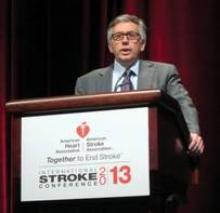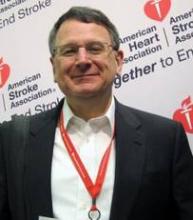HONOLULU – In patients with recent lacunar strokes, aggressive lowering of systolic blood pressure safely reduced the risk of recurrent stroke by about 20% in the BP intervention arm of the Secondary Prevention of Small Subcortical Strokes trial.
The primary endpoint of recurrent ischemic and hemorrhagic stroke was 2.3% per year in patients with a target systolic blood pressure of less than 130 mm Hg and 2.8% among those randomized to a target of 130-149 mm Hg (hazard ratio, 0.81; P = .08). Annual ischemic stroke rates also trended lower (2.0 vs. 2.4%; HR, 0.84; P = .19).
The lower blood pressure target, however, significantly reduced intracerebral hemorrhage by nearly two-thirds (0.11% vs. 0.29%; HR, 0.37; P = .03), Dr. Oscar R. Benavente reported on behalf of the Secondary Prevention of Small Subcortical Strokes (SPS3) investigators during a late-breaking plenary session at the International Stroke Conference.
The results are consistent with previous randomized controlled trials of BP lowering in stroke, but do not answer how low blood pressure should go or what the optimal target is, he said at a press briefing.
At 1-year follow-up, the average systolic BPs were 138 mm Hg and 127 mm Hg in the higher- and lower-target groups, having fallen from an average of 145 mm Hg and 144 mm Hg, respectively, at baseline.
Despite the lack of statistical significance for the primary endpoint, plenary session comoderator Dr. Steven Greenberg, professor of neurology at Harvard Medical School and director of hemorrhagic stroke research at Massachusetts General Hospital, both in Boston, told reporters, "as a clinician in practice, I would take these results very seriously."
He observed that clinicians often make decisions without a P value at the .05 level of certainty, and said the reduction in hemorrhagic stroke was a "very powerful finding" since studies have shown that the outcome from hemorrhagic stroke is even worse than that from ischemic stroke.
"This very much reinforces the impression that many of us already have – but now that the data are stronger – that we should aim for a lower blood pressure target in our patients," he said at the press briefing.
While the hemorrhagic stroke finding is important, the problem is that ischemic strokes make up the vast majority of recurrent strokes, commented Dr. Philip Gorelick, professor of translation science and molecular medicine, Michigan State University, and medical director of the Hauenstein Neuroscience Center, both in Grand Rapids, Mich.
"There wasn’t a clear-cut significance there, and so we’re still wrestling with this issue of where to drop that blood pressure point [to]," he said in an interview.
The intervention was well tolerated, however, "so you are not trading strokes for major safety events," pointed out Dr. Benavente of the brain research center, University of British Columbia, Vancouver.
As previously reported, the dual-therapy arm of SPS3 was stopped early because treatment with clopidogrel plus aspirin not only failed to significantly reduce the risk of recurrent stroke, but significantly increased the risk of all-cause mortality and major hemorrhage, compared with aspirin alone.
In the BP intervention arm, the higher- and lower-target groups had similar rates of serious complications of hypotension (15 events vs. 23 events; HR, 1.53; P = .20), including orthostatic syncope (5 events vs. 11 events; HR, 2.18; P = .14), stroke (1 event vs. 2 events; HR, 2.00; P = .57), myocardial infarction (0 events in both groups), and fall with injury (0 events vs. 3 events; HR and P not available).
Serious complications related to BP medications were limited to one case of bradycardia requiring hospitalization in the lower-target group, Dr. Benavente said at the conference, sponsored by the American Heart Association.
He also noted that there was no interaction between the BP intervention and diabetes, which was present in a little more than one-third of patients in both groups.
This finding is important since the American Diabetes Association recently raised its BP treatment goal from less than 130 mm Hg to less than 140 mm Hg to reflect clinical trial data showing limited benefit to more-intensive BP treatment in patients with diabetes, Dr. Gorelick observed. In the PROGRESS trial in which Dr. Gorelick served on the steering committee, he noted that it took at least 6 months for the curves to begin to separate for stroke recurrence.
"I think that blood pressures in the 130-139 [mm Hg] range is where you want to be, because you’re not going to know who’s going to have a hemorrhage; you’re not going to know who’s going to have a heart attack necessarily or a stroke; so I think we need to be reasonable here," he said.




